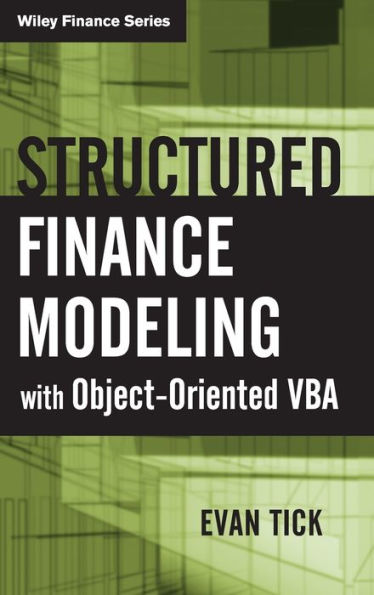Table of Contents
Preface xi
List of Acronyms xv
Acknowledgments xvii
About the Author xix
Chapter 1 Cash-Flow Structures 1
1.1 Getting Started 1
1.2 Securitization 3
1.3 Synthetic Structures 10
1.4 Putting It All Together 13
Chapter 2 Modeling 16
2.1 Dipping a Toe in the Shallow End 17
2.2 Swimming Toward the Deep End 22
2.3 Types 29
2.4 Class Architecture 33
2.4.1 Weak Inheritance 37
2.4.2 Parameterized Class 42
2.4.3 Which Is Better? 43
2.5 Exercises 46
Chapter 3 Assets 48
3.1 Replines 49
3.2 Portfolio Optimization 52
3.2.1 Zero-One Program 53
3.2.2 Simulated Annealing 56
3.3 Losses, Prepayments, and Interest Rates 60
3.4 Cash-Flow Model 61
3.4.1 Zero-Prepay Cash Flows 63
3.4.2 Actual Cash Flows 66
3.4.3 Examples 74
3.5 S&P Cash-Flow Model 75
3.5.1 Model Parameters 77
3.6 Moody’s Cash-Flow Model 80
3.6.1 Model Parameters 82
3.6.2 Algorithm 84
3.7 Option ARMs 86
3.8 Class Architecture: Multiple Inheritance 89
3.9 Doing It in Excel: SumProduct 94
3.10 Exercises 94
Chapter 4 Liabilities 98
4.1 Getting Started 98
4.2 Notation 102
4.3 Expenses 108
4.4 Interest 110
4.5 Over-collateralization 116
4.5.1 Current Subordinated Amount 116
4.5.2 Stepdown Date 118
4.5.3 Target Subordinated Amount 119
4.6 Principal 122
4.6.1 Gross Principal Distributions 122
4.6.2 Detailed Principal Distributions 124
4.7 Writedowns and Recoveries 128
4.8 Derivatives 130
4.8.1 Corridors 132
4.8.2 Swaps 134
4.8.3 Excess Reserve Fund Account 135
4.9 Triggers 137
4.9.1 Call Features 138
4.9.2 Overcollateralization Test 138
4.9.3 Interest Coverage Test 139
4.9.4 Delinquency Trigger 140
4.9.5 Loss Trigger 141
4.10 Residuals: NIMs and Post-NIM 141
4.11 Class Architecture 144
4.11.1 Passive Approach 144
4.11.2 Active Approach 158
4.11.3 Comparison 170
4.12 Doing It in Excel: Data Tables 170
4.13 Exercises 176
Chapter 5 Sizing the Structure 179
5.1 Senior Sizing 182
5.2 Subordinate Sizing 185
5.2.1 Fully Funded vs. Non–Fully Funded 190
5.3 Optimizations and Complexity 192
5.4 Example of Sizing 196
5.5 NIM and OTE Sizing 198
5.6 Class Architecture 203
5.6.1 Inheritance Revisited 203
5.6.2 Odds and Ends 207
5.7 Doing It in Excel: Solver 210
5.8 Exercises 213
Chapter 6 Analysis 217
6.1 Risk Factors 217
6.1.1 Prefunding 217
6.1.2 Prepayments 217
6.1.3 Buybacks and Cleanup Calls 219
6.1.4 Defaults 219
6.1.5 Interest Rates 221
6.1.6 Spreads 221
6.1.7 Miscellaneous 222
6.1.8 Residual Sensitivities 222
6.2 Mezzanine and Subordinate Classes 223
6.3 NIM Classes 230
6.4 Putting It All Together 232
6.5 Exercises 234
Chapter 7 Stochastic Models 235
7.1 Static versus Stochastic 235
7.2 Loss Model 238
7.2.1 Probability of Default from Transition Matrix 238
7.2.2 Probability of Default from Spread 241
7.2.3 Probability of Time to Default 242
7.3 Gaussian Copula 244
7.4 Monte Carlo Simulation 249
7.5 Synthetic Credit Indexes 251
7.5.1 Loss Lets 253
7.5.2 Analysis 256
7.5.3 Hedging 264
7.6 Doing It in Excel 270
7.7 Exercises 279
Appendix A Excel and VBA 285
A.1 Spreadsheet Style 286
A.2 Code Style 290
A.3 Compilation 295
A.4 Bloomberg 299
Appendix B Bond Math 303
B.1 Mortgage Payment 303
B.2 Yield to Price 305
B.3 Price to Yield 306
B.4 Duration 307
B.4.1 Index or Interest-Rate Duration 308
B.4.2 Discount Spread Duration 308
B.5 Hazard Rate 312
B.6 Static Credit Card Model 315
References 321
Index 325



